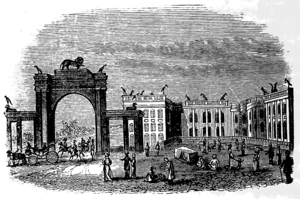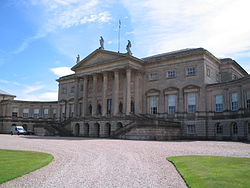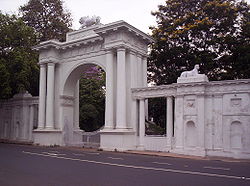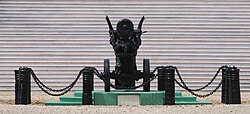Building
| Raj Bhavan, Kolkata | |
|---|---|
 Front façade of the Raj Bhavan Front façade of the Raj Bhavan | |
| General information | |
| Coordinates | 22°34′02″N 88°20′51″E / 22.567261°N 88.347520°E / 22.567261; 88.347520 |
| Current tenants | C. V. Ananda Bose, Governor of West Bengal |
| Construction started | 1799 |
| Completed | 1803 |
| Cost | Rupees 13 lakh (1,300,000) (£63,300) |
| Owner | Government of West Bengal |
| Technical details | |
| Floor area | 7,800 square metres (84,000 square feet) |
| Design and construction | |
| Architect(s) | Charles Wyatt |
| Other information | |
| Number of rooms | 90 |
Raj Bhavan is the official residence of the Governor of West Bengal, located in Kolkata, the capital of West Bengal. Built in 1803, it was known as Government House during the Company rule in India and the British Raj.
After the transfer of power from the East India Company to the British Crown in 1858, it became the official residence of the Viceroy of India, moving here from the Belvedere Estate. With the shifting of the Indian capital from then Calcutta to Delhi in 1911, it became the official residence of the Lieutenant Governor of Bengal. Since Indian independence in August 1947, it has served as the official residence of the Governor of West Bengal and is known as the Raj Bhavan, a name it shares with the official residences of other states' governors.
History


In the early nineteenth century, Calcutta was at the height of its golden age. Known as the City of Palaces or St. Petersburg of the East, Calcutta was the richest, largest and the most elegant colonial city of India.
Before 1799, the Governor-General of India resided in a rented house, called 'Buckingham House', located in the same location. The land belonged to Mohammad Reza Khan, a Nawab of Chitpur. In 1799, the 1st Marquess Wellesley, the then Governor-General, who is reputed to have said that "India should be governed from a palace, not from a country house", began the construction of a grand mansion.
After four years' construction, it was completed at a colossal cost of £63,291 (about £3.8 million in today's estimate). Lord Wellesley was accused of misusing the East India Company's funds and was finally recalled back to England in 1805.
After the transfer of power from the East India Company to the British Crown in 1858, it became the official residence of the Viceroy of India, moving here from the Belvedere Estate. In 1892, the Otis Elevator Company installed the first elevator in India at the Raj Bhavan.
Construction of New Delhi as the new capital of the British Raj was begun in 1911, with the chief official residence of the Viceroy and Governor-General being eventually moved there too, the new official residence being named Viceroy's House. The Lieutenant-Governor of Bengal, who had hitherto resided in Belvedere House, was upgraded to a full governor and transferred to Government House in Calcutta.
Architecture

Government House was designed by Capt. Charles Wyatt on the lines of Kedleston Hall, the Curzon family in Derbyshire. The building follows a neoclassical style with distinct Baroque overtones. In a strange coincidence, a 100 years after its construction started, the most illustrious son of the Curzon family, Lord Curzon, would come to occupy the building as the Viceroy and Governor-General of India (1899-1905). Curzon described the Government House as “without doubt the finest Government House occupied by the representative of any Sovereign or Government in the world.”
In 1860s, Viceroy James Bruce, 8th Earl of Elgin added the metallic Dome. Lord Curzon brought electricity and lift (popularly known as the ‘Bird Cage Lift") to Raj Bhavan.

The architectural plan comprises a central core with four radiating wings. The state rooms located in the central core are accessed from the outside by a flight of grand steps on the north. On the south is another portico surmounted by a colonnaded verandah with a dome above. The four wings accommodate the various offices and residential quarters along with four sets of staircases. The plan of the wings allows for a great deal of natural ventilation in the spaces while also permitting views across the gardens. The wings are decorated with large coats of arms.
The Raj Bhavan covers an area of 7,800 square metres (84,000 square feet) and is surrounded by a compound of 11 hectares (27 acres). The Raj Bhavan has six gateways, one each on the north and south and two each on the east and west. The four gates on the east and west have grand archways topped with lions, while the minor archways on the side are topped with sphinxes.

The best view of the Raj Bhavan is obtained from the North Gate, which also serves as the main gate. The main entrance, formed by six ionic pillars supporting a pediment, is approached by a long walk past a decorated Chinese cannon presented by Edward Law, 1st Earl of Ellenborough.
The Chinese cannon, mounted on a dragon and flanked with minor cannons, was brought from Nanking in 1842 after the First Opium War. An inscription on a marble plaque reads "The peace dictated to the Emperor of China under the walls of Nanking by the military force of England and of India".
Interior
The three-storeyed Raj Bhavan building has a huge central area consisting of large halls having curved corridors on all four sides radiating to detached wings, each constituting a house in itself. Including public halls, there are about 60 rooms in the building.
In 2017, West Bengal governor Keshari Nath Tripathi Indianised the names of these suites - the Prince of Wales suite was renamed to Rabindranath Tagore Kaksh; Wellesley Suite to Sagar Kaksh; Dufferin Suite to Kangchenjunga Kaksh; Anderson Suite to Vivekananda Kaksh.
Residential suites
The residential portion is divided into four suites. The Prince of Wales Suite in the north-west wing of the first floor hosts the President, Vice President and the Prime Minister of India and heads of state of other nations when they visit the state of West Bengal. The Wellesley Suite is located on the second floor in the north-eastern wing, the Dufferin Suite is on the second floor of north-west wing, and the fourth suite is the Anderson Suite.
Drawing and dining rooms
Yellow Drawing Room: Located on the first floor of the Raj Bhavan, the beautiful drawing room has some wonderful paintings.
Blue Drawing Room: An elegantly furnished room used by the governor to meet guest.
Brown Dining Room: Adjacent to the Blue Dining room, it is used for small conferences and meetings.
Halls and banquet rooms
Throne Room: The Throne Room contains the throne of Richard Wellesley. Beside it is throne of Tipu Sultan. The room contains oil paintings of Mahatma Gandhi, Subhas Chandra Bose, Jawaharlal Nehru, and Bidhan Chandra Roy. It also contains an urn used to carry the Mahatma Gandhi's ashes.
Council Chamber: The Governor General used the Council Chamber to preside over the executive and later the Legislative Council. It is now used by the Governor of West Bengal to hold large meetings. A small dining room known as the Bharat Ratna Room and a billiard room is located just outside the Council Chamber.
The Marble Hall: Located on the ground floor of the Raj Bhavan. It is used for state and private meetings.
The Banquet Hall: The Banquet Hall with rows of Doric pillars on each side, flowering chandeliers and black Mahogany tables has entertained eminent guests like Queen Elizabeth II.
Picture gallery
Old photos
-
 Government House, Calcutta, by John Christian Schetky
Government House, Calcutta, by John Christian Schetky
-
 A View of the Government House from the eastern side-1819. Engraved by R Havell Jr In Views of Calcutta and its Environs by James Baillie Fraser
A View of the Government House from the eastern side-1819. Engraved by R Havell Jr In Views of Calcutta and its Environs by James Baillie Fraser
-
 Calcutta - Government House, South Front, by Samuel Bourne
Calcutta - Government House, South Front, by Samuel Bourne
-
 New Government House at Calcutta by Samuel Davis
New Government House at Calcutta by Samuel Davis
-
 The Government House of Calcutta, bird's eye view, c. 1935
The Government House of Calcutta, bird's eye view, c. 1935
Present photos
-
Raj Bhavan on a foggy winter morning
-
 Raj Bhavan from South Gate
Raj Bhavan from South Gate
-
 Arched gate Raj Bhavan
Arched gate Raj Bhavan
-
 Raj Bhawan on a winter morning
Raj Bhawan on a winter morning
See also
References
- "Raj Bhavan | Kolkata City Tours".
- William, Dalrymple (2002). "White Mughals". Penguin Books. p. 407.
- Das Gupta, Prosenjit (2000). "10 Walks in Calcutta". Harper Collins. p. 5.
- SJM Research Journal. Vol. 25–26. Salar Jung Museum. 1988. p. 24.
- William, Dalrymple (2002). "White Mughals". Penguin Books. p. 346.
- "Richard (Colley), 1st Marquess of Wellesley, KP, Governor General of India, 1804". National Army Museum. Retrieved 4 January 2024.
- ^ "Colonial names removed from Kolkata Raj Bhawan suites". Asian Voice. 12 April 2017. Retrieved 4 January 2024.
- "We must continue to listen to the market". The Hindu. 17 August 2014. Retrieved 17 July 2016.
- Danvers, F.C. (22 June 2016). Bengal: Its Chiefs, Agents, and Governors. Forgotten Books. pp. 21–22. ISBN 978-1332869954.
- Roy, Nishitranjan,Swasato Kolkata Ingrej Amaler Sthapathya, (in Bengali), pp. 48, 1st edition, 1988, Prtikhan Press Pvt. Ltd.
- Ayers, Sydney (July 2019). "An English Country House in Calcutta: mapping networks between Government House, the statesman John Adam, and the architect Robert Adam". ABE Journal. 14–15.
- ^ Desmond, Doig. "An Artist's Impression". The Statesman.
- ^ "Raj Bhavan, Kolkata Chapter III: The Exterior" (PDF). Raj Bhavan, Kolkata. Retrieved 4 January 2023.
- ^ "Raj Bhawan, Kolkata on Wheels". Retrieved 21 January 2012.
- Strathcarron, Ian (2013). The Indian Equator Mark Twain's India Revisited. Dover Publications. p. 109. ISBN 978-0486315805.
External links
- The official website of Governor of West Bengal
- "Government House". Association of Commonwealth Archivists and Records Managers.
- "Government House, Calcutta". William Carey University.
- "Raj Bhavan". Catchcal. Archived from the original on 10 May 2008.
- "Raj Bhavan". clickindia. Archived from the original on 8 May 2012.
- Government House, Calcutta Undated 19th Century painting
| Raj Bhavan | |
|---|---|
|
| Tourist attractions in Kolkata | |
|---|---|
| Colonial | |
| Geographical | |
| Religious places | |
| Cultural |
|
| Boulevards |
|
| Shopping |
|
| Parks, riverfront, zoos and stadiums |
|